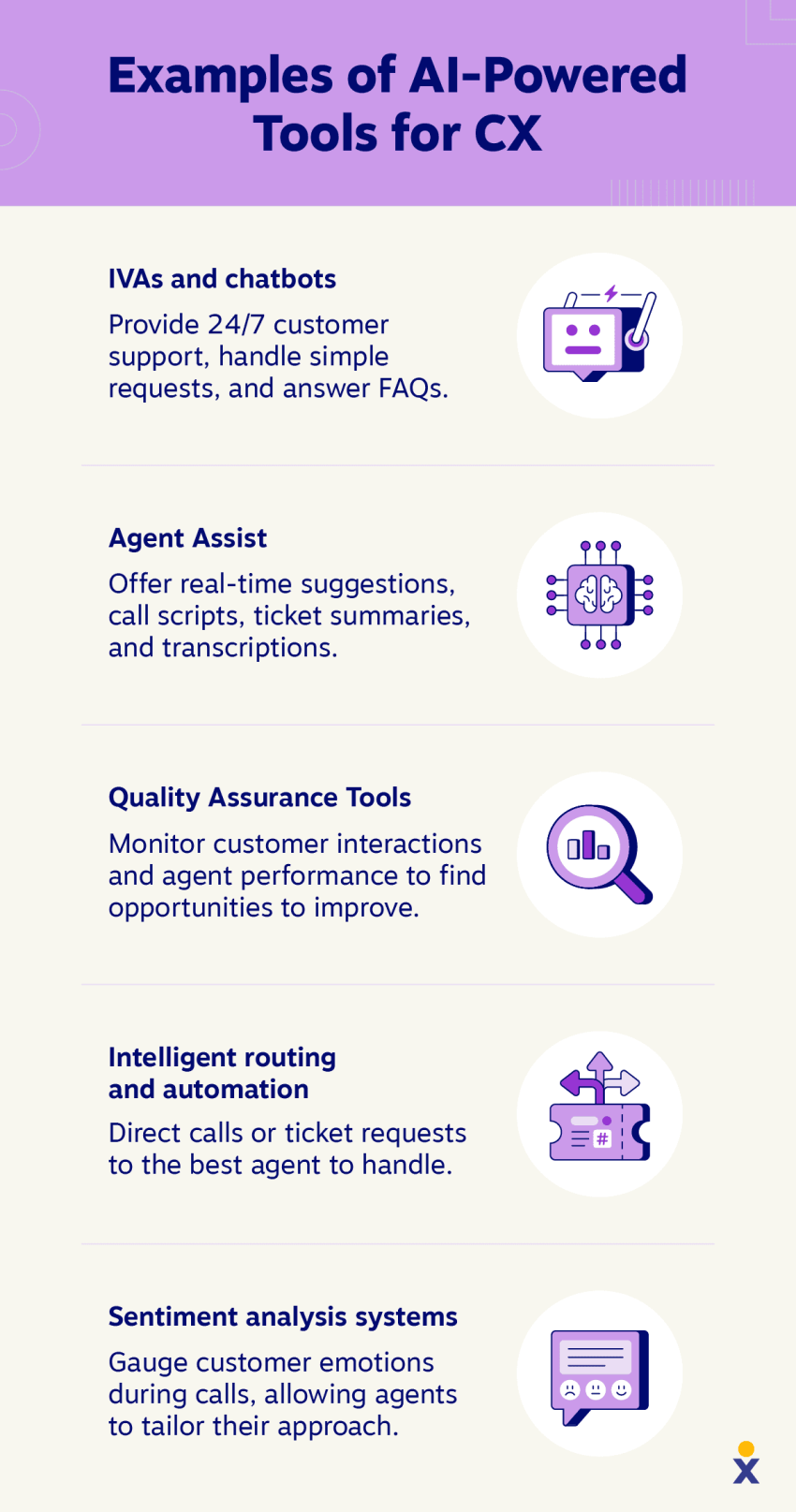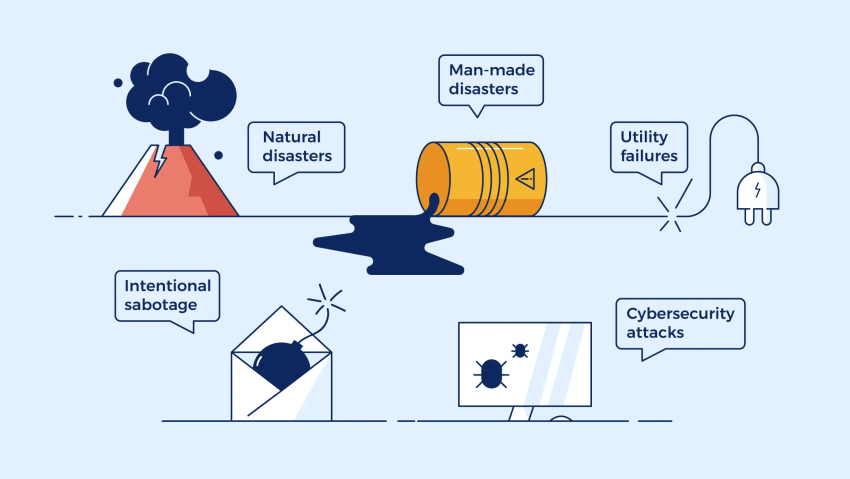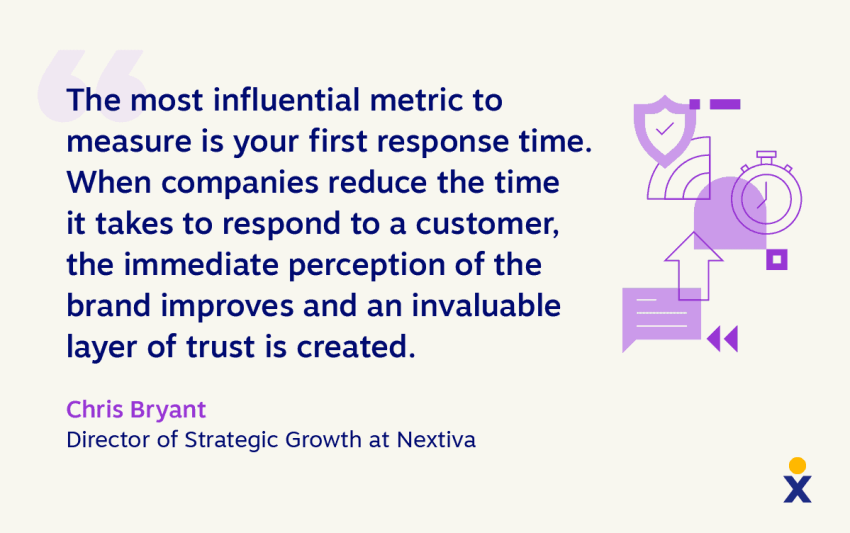Customer service technology is under pressure to do more with less. CX leaders are expected to support faster responses, AI-powered automation, and seamless omnichannel experiences, without adding tool sprawl. Nextiva’s 2025 research shows 92% of companies have adopted AI for CX, yet most still struggle with siloed systems and human–AI handoffs.
Cooking up excellent customer service experiences starts with the perfect recipe. And Chris Bryant, the director of strategic business growth at Nextiva, has all the right ingredients.
“Customers expect to get real-time responses. However, they also still expect quality, accuracy, and a human touch.”
To meet customer expectations, it’s important to analyze and follow customer service trends. Our list of emerging trends in customer service provides valuable insights to help you keep up with constantly evolving technologies and customer needs now and in the future.
Let’s take a closer look at each of these 12 customer service trends.
- AI-Driven Customer Experiences Aren’t Going Anywhere
- Higher Expectations Are Affecting Loyalty
- Omnichannel CX Is the Norm
- Hyper-Personalized Customer Engagement Is on the Rise
- Self-Service Options Are in Demand
- Remote and Virtual Support Teams Are Expanding
- Streamlined QA Processes Quickly Improve Customer Service
- Indirect Feedback Captures More Valuable Insights
- Increased Agent Training, Development, and Upskilling Are Growing
- Employee Wellness Is High-Priority
- Real-Time Data Is Driving Smarter Decisions
- Company Values Are Playing a Bigger Role in Customer Loyalty
1. AI-Driven Customer Experiences Aren’t Going Anywhere
Artificial Intelligence (AI) has already transformed customer service, but we’ve only just begun to scratch the surface. The technology is only getting better, now with the capabilities to handle complex inquiries with natural, human-like conversational flow. AI-powered chatbots and intelligent virtual assistants (IVAs) leverage different types of AI, such as Large Language Models (LLMs), Natural Language Processing (NLP), and Machine Learning (ML) algorithms, to understand language and provide personalized customer service in real time.

Along with AI chatbot and automation capabilities, generative AI advancements enable AI agents to understand the context and solve problems quickly. Because of the impact AI has on the customer experience (CX), this customer service trend is one to keep an eye on heading into the future.
2. Higher Expectations Are Affecting Loyalty
Customers have unlimited options at their fingertips — meaning growing expectations and shorter patience for bad customer service. In fact, one study found that 32% of customers said they would leave a brand they love after just one bad experience. Following customer experience best practices and implementing the right technology is an important customer service trend that can help your business exceed customer expectations and deliver stellar and effortless customer service throughout every interaction.
3. Omnichannel CX Is the Norm
If you want to build stronger relationships, providing an effortless and convenient customer experience is a good place to start. Customers like to communicate on their preferred channels, so adopting a platform that enables omnichannel support helps you meet them where they are. Omnichannel customer service creates a seamless and unified customer journey across all touchpoints, including social media, live chat, messaging, email, SMS, and more.
As technology advances and more communication channels become available, it’s important to have flexible software that can quickly adapt to changing customer needs.

For example, Nextiva’s omnichannel customer service software empowers agents to connect with customers on their preferred channels to resolve issues efficiently. It uses past interaction data for personalized experiences and ensures seamless transitions between channels while preserving interaction history.
| Interactions via social media channels make up 25% of support requests. ~Nextiva Contact Center Statistics Survey |
4. Hyper-Personalized Customer Engagement Is on the Rise
Stating the customer’s first name is the bare minimum when it comes to personalized customer service. To set your business apart, delivering hyper-personalized customer interactions can significantly increase customer satisfaction, brand loyalty, customer retention, and sales. How so?
Leveraging the customer data you collect and store in your CRM — such as customer preferences, purchase history, and past interactions — allows you to create tailored communication and accurate recommendations. Providing a consistent experience across all channels, no matter what channel customers start with (or switch to) — ensures a rich customer experience that makes customers feel valued and encourages repeat business, boosting customer lifetime value.
| 20% of businesses say empathetic customer service agents drive personalized customer experiences. ~Nextiva State of CX Survey |
5. Self-Service Options Are in Demand
Letting customers skip the queue does wonders for the customer experience. Customers like quick and easy service — and what’s faster than letting them handle the task themselves?
In addition to making 24/7 customer support available, customer self-service resources, like knowledge bases, FAQs, and customer service chatbots, allow customers to get in and get out, helping them find answers and resolve issues independently.
Sure, it’s good for the customer, but it’s also beneficial to your business, too. Self-service support is scalable and offers continuous availability without additional staffing costs. To get started, companies can evaluate past support tickets to identify common questions to help build out self-service knowledge base content.
6. Remote and Virtual Support Teams Are Expanding
There’s no such thing as “after hours” as customers expect around-the-clock support. Updating your business operations to include a remote workforce of human customer service reps at a virtual contact center eliminates the headache of off-hours that time zones create from on-site teams. Add an AI-powered customer service solution with AI agents to the fold and supercharge your customer service operation.
Keep in mind that remote teams need to see what your local teams see to create a seamless customer experience. Make sure these work-from-home teams have the right technology, like telecommuting software and remote collaboration tools, to keep them in the loop.

| Less than 10% of contact center operators have no remote call center employees. ~Nextiva Contact Center Statistics Survey |
7. Streamlined QA Processes Quickly Improve Customer Service
AI-powered call center quality assurance (QA) software makes great customer service even better by providing a more automated, objective, and data-driven approach to QA. Unlike traditional QA, which is time-consuming, subjective, and hard to scale, AI-powered QA software can efficiently analyze large volumes of data, ensuring consistent and unbiased evaluations.

This technology helps customer success teams identify areas for improvement, coach agents more effectively, and help your support teams consistently deliver exceptional customer experiences. Benefits include increased efficiency and scalability, objective and accurate assessments, automated coaching, sentiment analysis, and proactive issue identification.
8. Indirect Feedback Captures More Valuable Insights
Amplifying the voice of the customer (VOC) is a growing customer service trend that helps businesses gain insights, improve customer experience, and build stronger relationships by actively listening and acting on feedback. This extends beyond direct, traditional feedback to include social listening, online reviews, and other forms of indirect customer input. And because customers now expect customer-centric customer service, companies prioritizing VOC demonstrate their commitment to addressing customer needs.
Leveraging modern technology for real-time customer feedback collection, businesses can develop better products, improve customer service, and make data-driven decisions. However, it’s essential to listen to and act on feedback, address negative comments constructively, and manage large volumes of data effectively.
And don’t forget to respond to positive reviews, too.
9. Agent Training, Development, and Upskilling Are Growing
Increasing agent training, development, and upskilling are growing trends in customer service due to evolving customer needs and the rise of automation. Customers now expect support agents to handle complex products and services, navigate omnichannel interactions, and provide fast, personalized service. As automation takes over repetitive tasks, human agents must focus on complex issues and collaborate effectively with AI technologies.

Upskilling benefits include improved customer satisfaction, increased agent retention, enhanced problem-solving skills, and a stronger brand reputation. However, challenges include the cost and time investment required for training programs and the need to keep up with the constantly evolving customer service landscape.
10. Employee Wellness Is High-Priority
When businesses take care of employees like they take care of customers, everybody wins. The more employees feel valued and supported, and have opportunities for growth, the more engaged and motivated they are. This customer service trend results in better customer service and improved CSAT scores.
Prioritizing wellness also reduces agent burnout and employee turnover and fosters a positive company culture. Healthy and well-rested employees are more productive and efficient, resulting in quicker response times and improved problem-solving. Additionally, gamification tools boost employee engagement, and offering mental health days can further enhance employee motivation and well-being.
11. Real-Time Data Is Driving Smarter Decisions
Leveraging real-time data for actionable insights empowers customer service teams to be more proactive, efficient, and personalized. Traditional support relied on post-interaction customer feedback, limiting its effectiveness, whereas omnichannel analytics surfaces real-time data to capture valuable insights immediately.

Benefits of this customer experience trend include improved resolution rates by analyzing customer behavior and quickly identifying patterns, proactive support by flagging issues early, and predictive support by anticipating future needs based on customer data. Real-time data also enables personalized interactions, enhances the customer experience, and informs data-driven strategic decisions.
Examples include proactive live chat pop-ups offering assistance and predictive maintenance in IoT devices to prevent issues before they begin.
| 25% of CX leaders say they use reputation monitoring and analytics tools to handle customer interactions on online review sites. ~Nextiva Contact Center Statistics Survey |
12. Company Values Are Playing a Bigger Role in Customer Loyalty
Last but not least in our must-know customer service trends is that customers are more likely to buy from purpose-driven brands to support businesses that align with their values. This potent customer service trend enables businesses to forge deeper, emotional connections with customers, increasing loyalty with a customer base that aligns with what you stand for.
Examples include offering eco-friendly options, supporting charitable causes, and actively engaging in community initiatives, all of which can be highlighted in customer service interactions to reinforce shared values.
Communicating and demonstrating values like transparency, sustainability, and social responsibility creates a strong sense of trust. This also works internally. When a company’s values are integrated into its culture, employees become more engaged and stick around longer. At the same time, you also attract a wider talent pool of people who want to work for an amazing company.
The Future of Customer Service Starts with Nextiva
Providing standard customer service isn’t enough. Following customer service trends can help you keep up with changing customer expectations and give you a competitive advantage. The right customer experience software empowers you to deliver exceptional experiences at every touchpoint and build stronger customer relationships.
Customers base their decisions on the entire experience you provide, from initial interaction to purchase and beyond. CX software helps you identify areas for improvement and ensure a consistently high-quality experience for every user. Consider Nextiva’s CX solution, which offers omnichannel support, cloud-based communication tools, customer-centric features, data privacy, and scalable pricing to fit your needs. 👇
Surprise and delight your customers.
Have conversations with customers any way they prefer to communicate and work with teammates all in a single app.

















 Customer Experience
Customer Experience 






![How To Get More Customer Reviews [9 New Strategies & Ideas]](https://www.nextiva.com/cdn-cgi/image/width=850,height=478,fit=cover,gravity=auto,format=auto/blog/wp-content/uploads/sites/10/2023/09/How-to-Get-Reviews-for-Your-Business-scaled.jpeg?resize=768,432)







